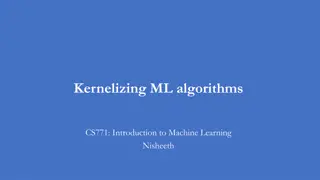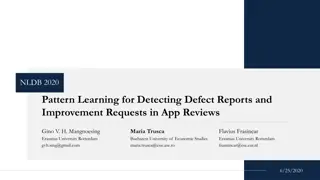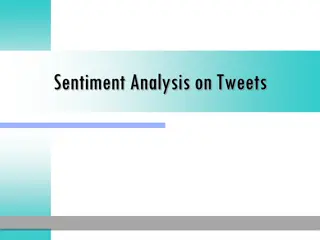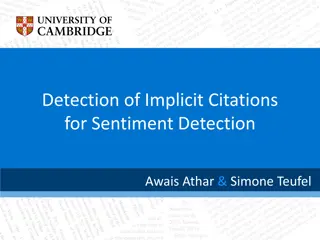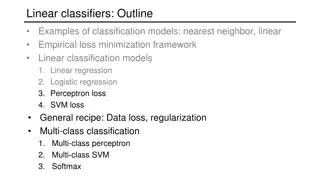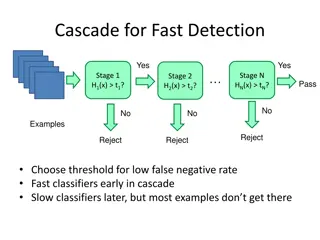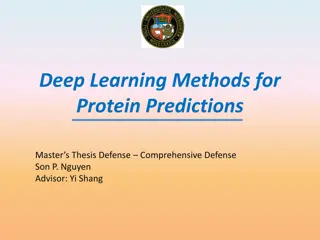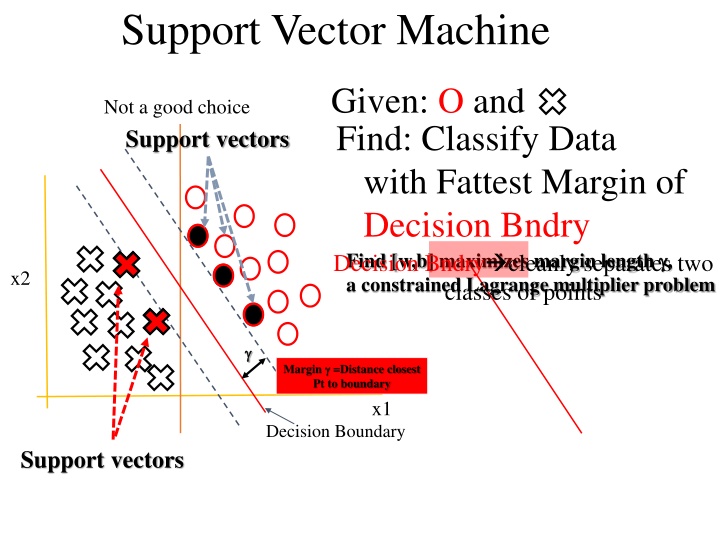
Support Vector Machine Overview and Application
"Explore the concepts and applications of Support Vector Machines (SVM) for classifying data with maximum margin separation. Learn about linear and non-linear SVM theories, dual solutions, and numerical examples. Gain insights into finding optimal parameters (w,b) for clean data classification."
Download Presentation

Please find below an Image/Link to download the presentation.
The content on the website is provided AS IS for your information and personal use only. It may not be sold, licensed, or shared on other websites without obtaining consent from the author. If you encounter any issues during the download, it is possible that the publisher has removed the file from their server.
You are allowed to download the files provided on this website for personal or commercial use, subject to the condition that they are used lawfully. All files are the property of their respective owners.
The content on the website is provided AS IS for your information and personal use only. It may not be sold, licensed, or shared on other websites without obtaining consent from the author.
E N D
Presentation Transcript
Support Vector Machine Support Vector Machine Support Vector Machine Given: O and Find: Classify Data with Fattest Margin of Decision BndryBest separator Find [w,b] maximizes margin length , a constrained Lagrange multiplier problem classes of points Not a good choice Support vectors Decision Bndry cleanly separates two x2 Margin =Distance closest Pt to boundary x1 Decision Boundary Support vectors
Support Vector Machine Support Vector Machine Outline Linear SVMt separator Non-Linear SVMt separator Dual Solutionseparator Numerical Examples Summary
Support Vector Machine Linear SVM Theory Given: Binary training data (x(i),y(i)) for i=[1,2,3 N] Find: (w,b) that cleanly classifies (x(i),y(i)) with fattest margin thickness y(i)=+/-1
Support Vector Machine Linear SVM Theory d Find {w , b} Given. Training Data. {x(n) , y(n) } x(n)d ^ x(n) - x d~w {x(n) x} w^ wTx(n) + b > 0 for x(n) above plane wTx(n) + b < 0 for x(n) below plane 0~w {x+b} ^ Perpendicular distance between x on margin plane and x(n)
Support Vector Machine Linear SVM Theory Given. Training Data. {x(n) , y(n) } Find {w , b} =|w (x(n)-x)| ^ wTx(n) + b > 0 for x(n) above plane wTx(n) + b < 0 for x(n) below plane Perpendicular distance between margin line and x(n) = y(n) | ? |(wTx(n) + b) Finds points closest to margin line Partial Goal: Given (w,b) s.t. 1 = | ? ||wTx(n) + b| Clean separation condition
Support Vector Machine Linear SVM Theory Partial Goal: Given (w,b) s.t. Clean separation condition
Support Vector Machine Linear SVM Theory Partial Goal: Given (w,b) s.t. This gives us for a given (w,b) Clean separation condition Final Goal: Find (w,b) s.t. This finds which Is fattest
Support Vector Machine Linear SVM Theory Final Goal: Find (w,b) s.t. This finds which Is fattest
Support Vector Machine Linear SVM Theory Final Goal: Find (w,b) s.t.
Support Vector Machine Linear SVM Theory Final Goal: Find (w,b) s.t. Quad. Programming Solution
Support Vector Machine Support Vector Machine Outline Linear SVMt separator Non-Linear SVMt separator Dual Solutionseparator Numerical Examples Summary
Support Vector Machine Support Vector Machine Non-Linear SVM Linear SVM doesn t work if x(n) not separable
Support Vector Machine Support Vector Machine Non-Linear SVM Step 1: Transform to z-space using polynomial transformation zi= (x)i Step 2: Linear SVM in z-space Penalty: Nz > Nx Higher costs
Support Vector Machine Support Vector Machine Summary: Non-Linear SVM Step 1: Transform to z-space using polynomial transformation zi= (x)i Penalty: Step 2: (w,b) in in z-space Nz > Nx Higher costs Step 3: For new pt x to be classified get x z and plug into wTz+b-1
Support Vector Machine Support Vector Machine Non-Linear SVM Linear SVMt separator Non-Linear SVMt separator Dual Solutionseparator Numerical Examples Summary
Support Vector Machine Support Vector Machine Dual Solution to SVM regularizer + n(wT x(n)+b)y(n) - 1) Find (w,b) s.t.: n =0 unless xn is a support vector where wTxn+b-1=0 Find that maximizes: Solution: Quadratic Programming where we eliminate w in terms of n Stationary conditions (2) x(n) support vectors Ah ha! Once QP finds n, then plug into eq. 2 to get w. Then plug n into wTx+b=1 to get b. Now classify new data
Support Vector Machine Support Vector Machine Dual Solution to SVM Find n s.t.: Correlation matrix=Dot products between x(n) and x(m) NxN Matrix! Yikes, N=#feature vectors. QP needs O(N3) to solve Hold everything! QP needs O(N3) to solve abone NxN matrix (N=# feature vectors) while the original primal problem only required Dx1 vector (w,b) costing O(M3). But D<<<N so sounds like a horrible strategy unless D>>N. Well, D>>>N if we are solving non-linear (w,b) with high dimension, such as kernel method.
Summary: Dual Solution to SVM Support Vector Machine Support Vector Machine Step 1: Transform Primal Dual Step 2: Solve for n by QP Step 3: Find w and b from n only for n associated with support vectors (non-support vectors make L smaller) w = n ny(n)x(n) and wT x+b=1 Step 4: Classify new data x: wTx+b-1>0 or wTx+b-1<0?
Support Vector Machine Support Vector Machine Outline Linear SVMt separator Non-Linear SVMt separator Dual Solutionseparator Numerical Examples SVM with General Kernels Soft Margin SVM Summary
min1/2 |w|2 Subject to wT x+b 1 if y(n)=1 wT x+b 1 if y(n)=1
Neural Network Intercept term Coherenc y Amplitud e Dipping Angle
Neural Network Misfit Function ? ? ? ? = 1 (?)??? (?)??? 1 ??(?) ??(?) ? ?=1 ?? + 1 ?? ? ? ?=1 ? number of Layer s
SVM Numerical Example Support Vector Machine Support Vector Machine [(x1,x2,x3),y]=[(dip, coherency,amp), noise/signal] Yuqing Chen
Support Vector Machine Support Vector Machine Numerical Example Log. Reg. n=1 Migration Image Log. Reg. n=2 Migration Image Yuqing Chen
Support Vector Machine Support Vector Machine Numerical Example Yuqing Chen
Support Vector Machine Support Vector Machine Outline Linear SVMt separator Non-Linear SVMt separator Dual Solutionseparator Numerical Examples SVM with General Kernels Soft Margin SVM Summary
Support Vector Machine Support Vector Machine General Non-Linear SVM Step 1: Transform to z-space using polynomial transformation zi= (x)i We did this by construction Penalty: Step 2: (w,b) in in z-space Nz > Nx Higher costs Dx1 Dzx1 ~ Step 3: For new pt x to be classified get x z(x) and plug into wTz+b-1 Step 3: Transform Primal Dual ~ ~ ~ z(n) ~ z(n)T z(m)T
Support Vector Machine Support Vector Machine General Non-Linear SVM Step 3: Transform Primal Dual ~ ~ ~ z(n) ~ z(n)T z(m)T
Support Vector Machine Support Vector Machine General Non-Linear SVM NxN matrix to invert, not a DzxDz Step 3: Transform Primal Dual ~ ~ z(n) ~ z(n)Tz(m) N Two good things: 1. O(NxN) rather than much larger O(DzxDz) matrix 2. Instead of an explicit construction of (x)i=zi we only need to specify k(x(n),x(m))=z(n)T z(m) without tedious specification of (x)i=zi, which could be infinite dimensional.
Support Vector Machine Support Vector Machine General Non-Linear SVM Example I: Previously we did construction, specify z(x) K(x,x ) z = (x) = (1, x1, x2, x12, x22 , x1 x2 ) z = (y) = (1, y1, y2, y12, y22 , y1 y2 ) Easy K Hard z K(x,y)= zT z = 1+ x1 y1 + x2 y2 + x12 y12 + x22y22 + x1y1 x2y2 Example II: Previously we did construction, specify z(x) K(x,x ). How about specify K(x,y) and find z? K(x,y) = (1+xTy) = (1+ x1y1 + x2y2)2 = (1+ x12 y12 + x22 y22 + 2x1y1 + 2x2y2 + 2x1y1 x2y2 ) z? Hard z = (x) = (1, x12 , x22, 2 x1, 2 x2 , 2 x1 x2 ) z = (y) = (1, y12 , y22, 2 y1, 2 y2 , 2 y1 y2 )
Support Vector Machine Support Vector Machine General Non-Linear SVM Example III: Gaussian kernel K(x,x ) = exp(-(x-x )2) = exp(-x2)exp(-x 2) k=1infty 2(x)k(x )k /k! = exp(-x2)exp(-x 2) + 2xx +x2x 2 + ] Therefore z(x) = exp(-x2) 2x , x2, ]. Infinite dimensional z ! Its ok, we only need K(x,x ) to classify new points! ~ ~ b obtained by substituting w into and solving for b in terms K(x,x ) Why? Answer: = n n ynzn and g(x)=sign( T z+ b) Substitute into g(x) givesg(x) = sign( n n yn zT zn+ b) = 1 obtained from dL/dwi = 0 = sign( n n yn K(x,xn ) + b) pred. No need to find z, only specify K(x,x )
Support Vector Machine Support Vector Machine Summary: Kernel SVM 1. Pick suitable K(x,x ) = exp(-(x-x )2) so that K symmetric and positive semi-definite 2. Solve for n the reduced Lagrangian K(xn,xm) T T y1yN K(x1 ,xN) T y1y2 K(x1 ,x2) y1y1 K(x1 ,x1) T T T T T y1y1z1 z1 y2y1z1 z2 y2y1 K(xN , x1) y1y2z1 z2 y1y2z1 zN y2y2z2 z2 y2yNz2 zN y2y2 K(xN, x2) y2yN K(x2 ,xN) T y2y2 K(x2 ,x2) y2y1 K(x2 ,x1) T T T yNy2zN z2 yNyNzN zN T T T yNy1zN z1 T T y2yN K(xN ,xN) T 3. Classify new x by g(x)= sign( n n yn K(x,xn ) + b) Sum over support vectors in z-space K(x,xn ) = exp(-(x-xn)2) ~ ~ b obtained by substituting w into and solving for b in terms K(x,x ) = 1
Support Vector Machine Support Vector Machine Outline Linear SVMt separator Non-Linear SVMt separator Dual Solutionseparator Numerical Examples Soft Margin SVM Summary
Support Vector Machine Support Vector Machine Outline Linear SVMt separator Non-Linear SVMt separator Dual Solutionseparator Numerical Examples Soft Margin SVM Summary
Summary Linear SVM: Non-linear SVM: Dual-Space SVM: Kernel trick: don t compute -dimensional vector z(x), just specify K(x, x ) and find by QP. Then find prediction for new x by





